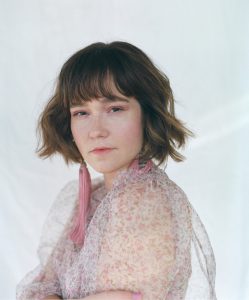Singer-songwriter Sara-Danielle has just released her second EP, Another Self, but she’s already pining to return to the studio for her next project, and she might even do it alongside producer Jesse Mac Cormack once again, since he served her songs so well. “Plus, lately, I feel like writing songs by working on the lyrics first,” she adds. “It’s like I want to say more precise things, whereas I used to start with the music. Nowadays, I feel like starting with the lyrics will lead the music to manifest itself on its own, according to what I want to share.”
 As with most of us, the last two years have been a time of soul-searching for Sara-Danielle, who fortunately didn’t have to put her budding career on hold: the EP was ready months ago, and was released by Simone Records when it was scheduled. The wait was worthwhile: her offering is a mix of mature pop songs, gently tinged with soul, and refined by Mac Cormack’s orchestrations, achieving a perfect balance between acoustic instruments and synthetic flourishes. (Drummer Louis René contributed to the recordings).
As with most of us, the last two years have been a time of soul-searching for Sara-Danielle, who fortunately didn’t have to put her budding career on hold: the EP was ready months ago, and was released by Simone Records when it was scheduled. The wait was worthwhile: her offering is a mix of mature pop songs, gently tinged with soul, and refined by Mac Cormack’s orchestrations, achieving a perfect balance between acoustic instruments and synthetic flourishes. (Drummer Louis René contributed to the recordings).
However, during the pandemic, Sara-Danielle “felt a lot of relationships change. The songs I’m writing these days are a bit of a sequel to the EP,” meaning a reflection on her relationship with others, with her friends, but also a reflection on the feeling of loss of freedom imposed by self-isolation.
“I want to feel free and, I don’t know… Feel like I’m moving forward. As we’ve all felt these last few years, I felt trapped, stuck. I’m really anxious for things to move forward again. I’m getting impatient!” insists the musician, who started her solo project six years ago, and launched her first EP, Healing (2019), as a lyricist.
Sara-Danielle enjoys the music of Liana La Havas and Lana Del Rey, and you can hear it. “I love Liana La Havas’s powerful yet soft aura, I find her very inspiring,” she says. “I love sparse music with catchy R&B rhythms. I love stuff like that, where you feel the rhythmic pulse,” which one hears in her own output. “I think it’s actually fun that it’s devoid of ornamentation and totally gentle.” As for Lana Del Rey, “she uses her voice in very special ways, especially on her most recent album,” says the artist. “I also like to play with my voice to create textures and atmospheres. For my EP, I wanted to create something that mixed the organic side of R&B with electronic textures.”
That, too, is easy to hear, just as her formal training as a jazz singer at Université de Montréal is noticeable, in the way she controls her voice effortlessly. This training was the logical next step after completing the Musique et chanson program at Cégep Marie-Victorin. Less obvious is the fact that she learned music through traditional Québécois repertoire.
“My first instrument was the violin,” says the Gatineau-born musician, whose mother is a Franco-Ontarian. “I was introduced to music through Québécois reels which I listened to and played in my childhood and teens. My father’s a good singer, and he played mandolin, and my grandmother was involved in the traditional music community, so there was a lot of jamming going on at home!”
Yet, by growing up on the provincial border with Québec, Sara-Danielle was mostly exposed to Anglophone pop. “That’s my inspiration, I wrote my first songs in English,” she says. She started by dreaming of an international career in English, although for awhile, she felt overshadowed by her friends who were pursuing projects in French. “I saw them being invited to Francouvertes, for example, and I’d think to myself: ‘It’s really saddening that there are no contests or showcases like that for Anglo artists in Québec.’ I felt like I was falling through the cracks. So, I figured that if I couldn’t participate in those contests, I needed to surround myself with a great team. I sent demos everywhere, and that’s how I found my manager and my label.”
Her collaboration with Jesse Mac Cormack has finally allowed her to strengthen her musical identity, even though the Montréaler – currently releasing his new album, SOLO – is known for having his own signature sound, regardless of the projects on which he’s invited to work.
“It’s undeniable that he has his brand – you immediately know when an album was produced by him when you hear it,” Sara-Danielle readily admits. “I’ll be honest: I hadn’t thought about that when I walked into the studio; all I wanted was to work with someone who was a good fit. Such a fit between two musical personalities is important, just as important as being able to listen to the other. The fit was immediate between us, and he didn’t try to impose his sound on my songs. I showed up with my compositions and he just embellished them, naturally.
“I found it helpful to get to the studio with well thought-out compositions, lyrics, music, structure, and a good idea of where I wanted them to go, sonically. My ideas were clear enough to guide Jesse; he knew the direction I wanted to go in, like ‘the rhythm I hear is more like this, or that.’ He was the perfect complement to me, I never felt like he was taking up all the space.”